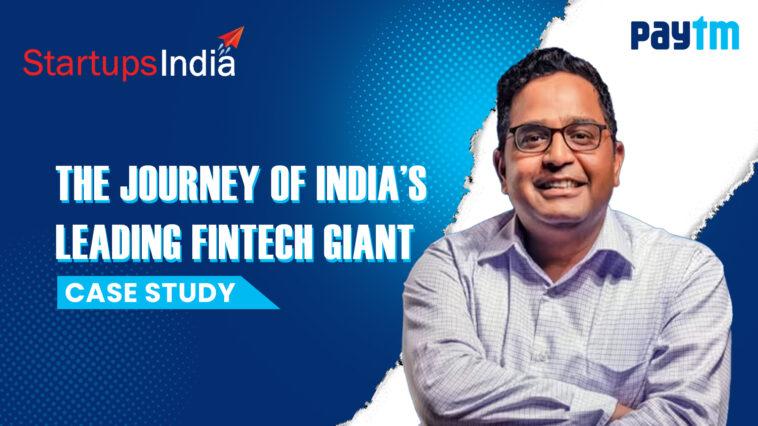Introduction
Paytm, short for “Pay Through Mobile,” is one of India’s most successful fintech companies. Founded in 2010 by Vijay Shekhar Sharma, Paytm revolutionized digital payments in India. It started as a mobile recharge platform and later expanded into wallet services, UPI payments, e-commerce, financial services, and stock trading. Today, Paytm is a publicly traded company with a strong market presence in digital payments, making it an inspiring case study for students and entrepreneurs.
Founding Story and Vision
Early Struggles
Vijay Shekhar Sharma, a passionate entrepreneur, envisioned a cashless India. Despite financial difficulties and initial skepticism, he launched Paytm under One97 Communications Ltd. in 2010. His goal was to make digital transactions seamless and accessible to every Indian, even those without bank accounts.
Vision
Paytm aimed to become a one-stop solution for digital payments by leveraging smartphone penetration and increasing internet access. The company’s core mission was to enable financial inclusion, especially for small businesses and underserved populations.
Unique Strategies That Set Paytm Apart
Paytm’s rise to success can be attributed to several key strategies that differentiated it from competitors:
1. First-Mover Advantage in Mobile Wallets
- Paytm introduced its mobile wallet in 2014, long before digital payments gained mainstream popularity in India.
- This move positioned Paytm as a pioneer, allowing it to dominate the digital wallet segment before UPI took over.
2. Strategic Partnerships and Investments
- Paytm partnered with Uber, IRCTC, and various e-commerce platforms to integrate its payment gateway, increasing adoption.
- The company secured investments from major players like Alibaba, SoftBank, and Warren Buffett’s Berkshire Hathaway, which provided financial backing for rapid expansion.
3. Leveraging Demonetization (2016)
- In November 2016, the Indian government’s demonetization policy created a huge demand for digital payments.
- Paytm capitalized on this opportunity by aggressively marketing its wallet and onboarding millions of new users.
- The tagline “Ab ATM Nahi, Paytm Karo” became a nationwide trend, further strengthening its brand.
4. Super App Model
- Paytm evolved into a super app, offering services like mobile recharges, bill payments, e-commerce, flight bookings, insurance, and stock trading.
- This diversified its revenue streams and made it an indispensable part of users’ daily financial activities.
5. Expansion into Financial Services
- Paytm expanded beyond payments, introducing Paytm Payments Bank, mutual funds, insurance, personal loans, and stock trading.
- This move positioned it as a full-fledged fintech ecosystem rather than just a digital wallet.
6. Focus on Merchants and Offline Payments
- Paytm aggressively targeted small businesses by offering QR-code-based payments.
- The launch of Paytm Soundbox gave real-time payment confirmations, making digital transactions easier for shopkeepers.
- This strategy helped Paytm onboard millions of offline merchants, strengthening its UPI and wallet dominance.
7. Gamification and Customer Engagement
- Paytm introduced cashback offers, scratch cards, and referral programs to boost user engagement.
- Seasonal campaigns and promotions during festivals like Diwali and Holi helped attract more users.
- Personalized rewards and loyalty programs increased customer retention.
Revenue and Funding Growth
Paytm’s financial journey showcases impressive growth:
- Revenue Growth:
- FY 2017: ₹813 crore
- FY 2019: ₹3,579 crore
- FY 2021: ₹3,186 crore
- FY 2023: ₹7,990 crore
- Funding Details:
- 2015: Raised $680 million from Alibaba Group.
- 2017: Raised $1.4 billion from SoftBank, boosting expansion plans.
- 2021: Raised ₹18,300 crore ($2.4 billion) in India’s largest-ever IPO, but its post-IPO performance faced challenges.
Challenges Faced
Despite its success, Paytm encountered several hurdles:
- Intense Competition: Faced growing competition from Google Pay, PhonePe, and traditional banks offering UPI services.
- Regulatory Issues: RBI imposed restrictions on Paytm Payments Bank due to compliance concerns, affecting its banking operations.
- Post-IPO Struggles: After a record-breaking IPO in 2021, Paytm’s stock plummeted, raising concerns about profitability.
- Burn Rate and Profitability: Heavy investments in expansion led to significant cash burn, delaying profitability.
- Consumer Trust Issues: Data privacy and security concerns occasionally affected customer confidence.
- Shifting Business Model: As UPI overtook wallets, Paytm had to pivot towards merchant services and financial products to stay relevant.
Growth and Expansion
- Paytm Payments Bank: Introduced in 2017, offering zero-balance accounts and digital banking services.
- Paytm for Business: Onboarded millions of merchants for QR code-based UPI payments.
- International Expansion: Entered Canada and Japan through strategic partnerships.
- Paytm Money: Launched investment services, including mutual funds and stock trading.
- Paytm Soundbox: Introduced a smart speaker for merchants, enhancing the offline payment experience.
- Paytm Credit Services: Launched BNPL (Buy Now, Pay Later) options and small loans to increase customer engagement.
Key Takeaways for Entrepreneurs and Students
- Identify Market Trends: Paytm capitalized on mobile penetration and government initiatives like demonetization.
- Adapt Quickly: Shifting from a wallet-based model to UPI helped Paytm stay relevant despite market changes.
- Strategic Funding: Securing investments from Alibaba and SoftBank enabled rapid expansion.
- Branding Matters: The phrase “Paytm Karo” became synonymous with digital payments in India.
- Diversification is Key: Expanding beyond payments into banking, insurance, and stock trading ensured sustained growth.
- Challenges are Inevitable: Regulatory hurdles and competition tested Paytm’s resilience but did not deter its vision.
- Super App Approach: Offering multiple services under one platform increased user engagement and retention.
- Localization Strategy: Paytm focused on India-first solutions, like multi-language support and QR-based payments.
- Merchant-Centric Approach: Focusing on offline retailers helped sustain its growth beyond just consumer payments.
Conclusion
Paytm’s journey from a mobile recharge platform to a fintech powerhouse exemplifies how innovation, adaptability, and strategic partnerships can drive success. Despite challenges, it remains a dominant player in India’s digital finance sector. Entrepreneurs and students can learn valuable lessons from Paytm’s agility, vision, and ability to turn challenges into opportunities.
As Paytm continues to evolve, it serves as an inspiration for startups aiming to disrupt traditional industries through technology and innovation.




GIPHY App Key not set. Please check settings